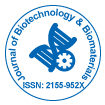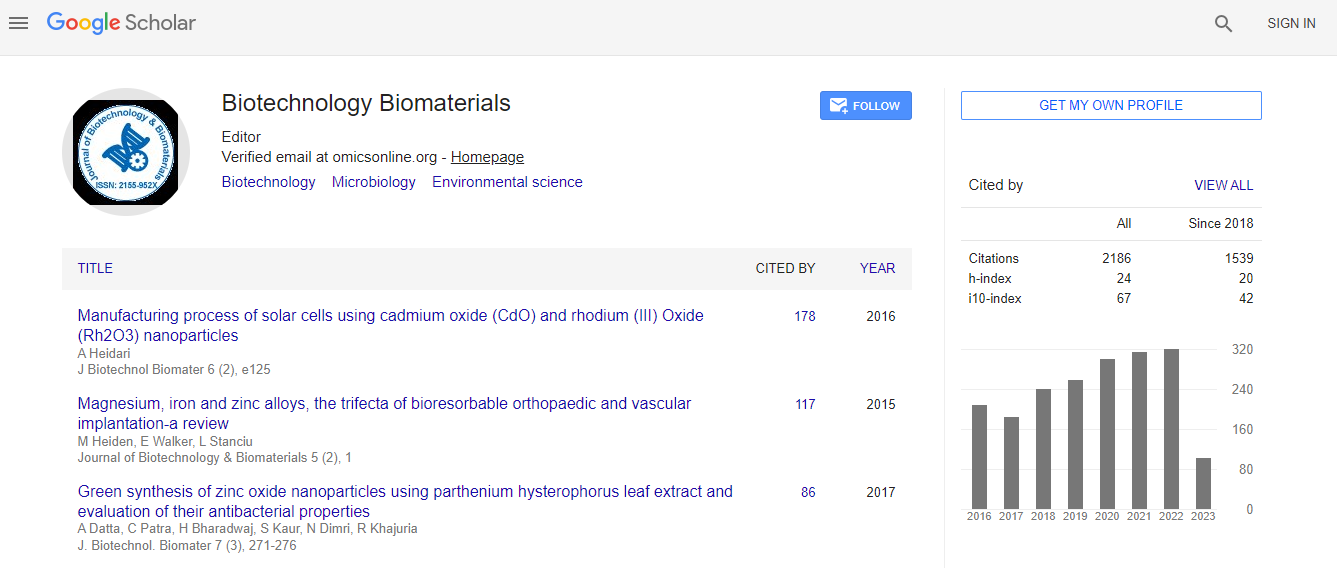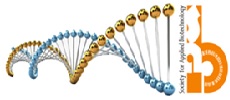Our Group organises 3000+ Global Conferenceseries Events every year across USA, Europe & Asia with support from 1000 more scientific Societies and Publishes 700+ Open Access Journals which contains over 50000 eminent personalities, reputed scientists as editorial board members.
Open Access Journals gaining more Readers and Citations
700 Journals and 15,000,000 Readers Each Journal is getting 25,000+ Readers
Google Scholar citation report
Citations : 3330
Journal of Biotechnology & Biomaterials received 3330 citations as per Google Scholar report
Indexed In
- Index Copernicus
- Google Scholar
- Sherpa Romeo
- Open J Gate
- Genamics JournalSeek
- Academic Keys
- ResearchBible
- China National Knowledge Infrastructure (CNKI)
- Access to Global Online Research in Agriculture (AGORA)
- Electronic Journals Library
- RefSeek
- Hamdard University
- EBSCO A-Z
- OCLC- WorldCat
- SWB online catalog
- Virtual Library of Biology (vifabio)
- Publons
- Geneva Foundation for Medical Education and Research
- Euro Pub
- ICMJE
Useful Links
Recommended Journals
Related Subjects
Share This Page
Investigation of 3D printable biocompatible orthodontic polymers
3rd Annual Conference and Expo on Biomaterials
Melinda Szaloki, Ferenc Toth, Sara Khandan, Hamid Javadi and Csaba Hedegus
University of Debrecen, Hungary
ScientificTracks Abstracts: J Biotechnol Biomater
Abstract
Biocompatible MED620 and MED610 polymers are 3D printable materials used mainly in oral surgery and orthodontics. Researchers have reported that MED610 significantly reduced the cell numbers of keratinocytes, even in non-direct contact. The purpose of this study is to investigate the effect of different surface manipulations on cell proliferation, surface specific oligopeptides regarding MED610 and to compare to MED 620 and MED610 regarding degree of conversion (DC), polymerization shrinkage (PS) (Stratasys, USA). The MED610 and MED620 samples were printed by Objet30 OrthoDesk (Stratasys, USA) 3D printer. In cell proliferation study osteosarcoma (Saos-2) and dental pulp stem cells (DPSC) were used. The surface manipulation was done by two methods of support material removal. 7-mer oligopeptides was used to determine surface specific peptides based on New England Biolabs protocol. The PS of polymers was measured based on Archimedes├?┬ó├?┬?├?┬? principle by an analytical balance (Adam PW 254, UK). A Nicolet 6700 Fourier Transform Infrared spectroscope (FTIR) (Thermo Electron Co. USA) in attenuated total reflectance (ATR) mode was used for DC measuring. The surface treatment has an effect on cell proliferation and surface specific oligopeptides. The PS of MED620 and MED610 photopolymers were 7.56 V/V% ├?┬?├?┬▒ 0.12 and 8.17 V/V % ├?┬?├?┬▒ 0.24, respectively. The DC of MED620 and MED610 samples 93.34 % ├?┬?├?┬▒ 2.66 and 97.76 % ├?┬?├?┬▒ 1.31, respectively. Based on the results of the study it was found that the chemical modification of polymer surface influence the numbers of the attached cells, sequence of surface specific peptides and the physical properties i.e. polymerization shrinkage and degree of conversion that can be related to the different application and composition of the 3D printable biocompatible orthodontic polymers. Recent publications 1. Schmelzer E, Over P, Gridelli B, Gerlach JC (2016) Response of primary human bone marrow mesenchymal stromal cells and dermal keratinocytes to thermal printer materials in vitro. Journal of medical and biological engineering 36: 153├?┬ó├?┬?├?┬?167. 2. Vodnik M, Strukelj B, Lunder M (2012) HWGMWSY, an unanticipated polystyrene binding peptide from random phage display libraries. Analytical biochemistry 424: 83-86. 3. Szaloki M, Radics T, Hegedus Cs (2016) Characterization of dental allergy associated polymer surfaces by phage display technique. Fogorvosi szemle 109: 75-80. 4. Dodziuk H (2016) Applications of 3D printing in healthcare. Polish journal of cardio-thoracic surgery 13: 283├?┬ó├?┬?├?┬?293. 5. Walsh ME, Ostrinskaya A, Sorensen MT, Kong DS, Carr PA (2016) 3D-Printable materials for microbial liquid culture. 3D printing and additive manufacturing 3: 113-118.Biography
Melinda Szalóki, chemist, defended her doctoral thesis with the qualification of summa cum laude in 2013. In her PhD thesis she summarized the results of her 10 years research work, the application possibilities of reactive polymer nanoparticles in dentistry. The supervisor was Prof. Csaba Heged├?┬▒s MD, LDS, PhD. Her results was published in international journals, in Colloid and Polymer Science, in Macromolecules and in Reactive and Functional Polymers. In 2013, she has won Ányos Jedlik Doctoral Candidate Scholarship in the framework of TÁMOP4.2.4.A/2-11/1-2012-0001‘National Excellence Program’. The topic of the ongoing research is the investigation the bindings of oligopeptides to poly methyl methacrylate (PMMA) surface by phage display and Fourier transformation surface plasmon resonance spectroscopy (FT-SPR). She is involved in the education activities of Dental Materials and in Student’s Research Work as a supervisor. Dr. Melinda Szalóki was awarded on the IAAM 2016 (by the International Association of Advanced Materials) in Stockholm. Her research area are immediate repair of resin based composite, characterization of 3D printable dental polymers, application possibility of gold nanoparticles in dentistry and investigation of biomolecular interaction with phage display and Fourier Transformed Surface Plasmon Resonance (FT-SPR) spectroscope.
Email:szaloki.melinda@dental.unideb.hu

 Spanish
Spanish  Chinese
Chinese  Russian
Russian  German
German  French
French  Japanese
Japanese  Portuguese
Portuguese  Hindi
Hindi 
